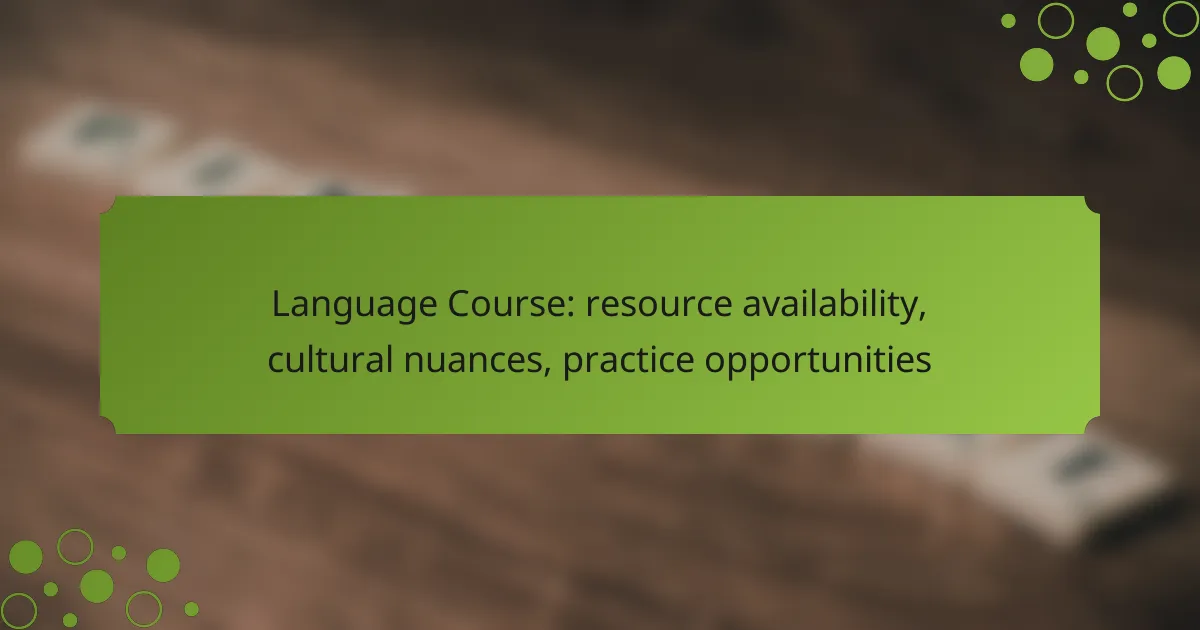In Canada, a variety of online language courses are available for English learners, featuring platforms like Duolingo, Rosetta Stone, and Babbel, each tailored to different learning styles. Understanding cultural nuances is crucial as it affects communication and expression, enriching the learning experience. Additionally, learners can find ample opportunities to practice their skills through community resources and activities, which not only improve fluency but also deepen cultural understanding.

What online language courses are available in Canada?
In Canada, several online language courses cater to English learners, offering diverse methods and resources. Popular platforms include Duolingo, Rosetta Stone, and Babbel, each with unique features and pricing structures to suit different learning preferences.
Duolingo English Course
Duolingo offers a free, gamified approach to learning English, making it accessible for learners of all ages. The course includes bite-sized lessons that cover vocabulary, grammar, and pronunciation through interactive exercises.
One of the key benefits of Duolingo is its flexibility; learners can practice anytime and anywhere using their mobile app or website. However, while it is a great starting point, it may not provide in-depth cultural context or conversational practice.
Rosetta Stone English Program
Rosetta Stone focuses on immersive learning, emphasizing visual and audio cues to teach English. This program is subscription-based, with options for monthly or yearly payments, and often includes live tutoring sessions.
Its structured lessons are designed to build language skills progressively, making it suitable for serious learners. However, the cost can be higher compared to other platforms, which may be a consideration for budget-conscious students.
Babbel English Language Course
Babbel provides a subscription service that offers tailored English lessons focusing on real-life conversations and practical vocabulary. The course is designed by linguists and covers various topics, making it relevant for everyday use.
With a user-friendly interface, Babbel allows learners to track their progress and revisit challenging topics. While it is effective for building conversational skills, some users may find the content less engaging compared to more interactive platforms like Duolingo.

How do cultural nuances affect language learning?
Cultural nuances significantly influence language learning by shaping how expressions, idioms, and communication styles are understood. Recognizing these subtleties helps learners navigate social interactions and enhances their overall fluency.
Understanding Canadian English dialects
Canadian English features distinct dialects that vary across regions, influenced by both British and American English. For instance, speakers in Ontario may use different vocabulary and pronunciation compared to those in British Columbia or Newfoundland.
Familiarity with these dialects can improve comprehension and communication. For example, the pronunciation of “about” often sounds like “aboot” in some regions, which can be surprising for learners. Engaging with local media, such as television shows or podcasts, can help learners adapt to these variations.
Regional idioms and expressions
Regional idioms and expressions in Canada can differ widely, adding layers of meaning that are often tied to local culture. Phrases like “toque” for a winter hat or “double-double” for a coffee with two creams and two sugars are commonly used in Canada but may confuse non-native speakers.
To effectively communicate, learners should familiarize themselves with these idioms. A practical approach is to create a list of common expressions and practice using them in context. Engaging with native speakers in conversation can also provide valuable insights into the appropriate use of these phrases.

What practice opportunities exist for English learners in Canada?
English learners in Canada have numerous opportunities to practice their language skills through various platforms and community resources. Engaging in these activities can significantly enhance fluency and comprehension while also providing cultural insights.
Language exchange meetups
Language exchange meetups are informal gatherings where individuals can practice speaking English with native speakers and other learners. These events often take place in cafes, community centers, or online platforms, allowing participants to engage in conversation and share cultural experiences.
To find a meetup, check local community boards, social media groups, or websites like Meetup.com. It’s beneficial to attend regularly to build relationships and improve language skills over time.
Online conversation partners
Online conversation partners connect English learners with native speakers through video calls or chat platforms. This setup allows for flexible scheduling and the ability to practice from anywhere in Canada.
Websites such as Tandem or HelloTalk facilitate these connections, enabling users to find partners based on shared interests or language goals. Aim for consistent practice, ideally a few times a week, to see significant improvement.

What are the prerequisites for enrolling in language courses?
Prerequisites for enrolling in language courses typically include a basic understanding of the language, as well as access to necessary materials. Some courses may require a placement test to determine your current proficiency level.
Basic language proficiency assessment
A basic language proficiency assessment helps identify your current skills and ensures you enroll in a course suitable for your level. Many institutions offer online assessments that evaluate reading, writing, listening, and speaking abilities.
Consider taking a standardized test, such as the Common European Framework of Reference for Languages (CEFR), which categorizes proficiency from A1 (beginner) to C2 (proficient). This can guide your course selection and help set realistic learning goals.
Required materials and resources
Required materials for language courses often include textbooks, workbooks, and access to online platforms or apps. Check with your course provider for specific recommendations, as these can vary widely based on the language and level.
Additionally, consider supplementary resources such as language exchange partners, conversation clubs, or cultural immersion programs. These can enhance your learning experience and provide practical application opportunities beyond the classroom.

How to choose the right online language course?
Choosing the right online language course involves evaluating the course’s content, structure, and the qualifications of the instructors. Consider your learning goals, preferred teaching styles, and the availability of practice opportunities to ensure the course meets your needs.
Course content and structure
The course content should align with your language goals, whether for travel, business, or academic purposes. Look for programs that offer a balanced mix of grammar, vocabulary, and practical conversation skills.
Additionally, consider the course structure. Some courses are self-paced, allowing you to learn at your convenience, while others follow a set schedule with live classes. Choose a format that fits your lifestyle and learning preferences.
Instructor qualifications and experience
Instructors should have relevant qualifications, such as degrees in linguistics or teaching certifications. Experienced teachers can provide valuable insights and effective teaching strategies that enhance your learning experience.
Check for reviews or testimonials regarding the instructors’ teaching styles and effectiveness. Engaging and knowledgeable instructors can significantly impact your motivation and progress in the language course.

What are the costs associated with online language courses?
The costs of online language courses can vary significantly based on the type of course and payment structure. Factors such as subscription models, one-time payment options, and additional resources can influence the overall expense.
Subscription models for platforms
Subscription models typically charge a recurring fee, often monthly or annually, granting access to a range of language learning materials and features. Prices can range from around $10 to $50 per month, depending on the platform’s offerings and the depth of content available.
These models often include benefits like regular updates, community access, and interactive features. However, users should consider their commitment level, as ongoing payments can add up over time.
One-time payment options
One-time payment options allow learners to pay a single fee for lifetime access to a specific course or set of resources. Prices for these courses can vary widely, typically ranging from $50 to several hundred dollars based on the course’s comprehensiveness and the platform’s reputation.
This approach can be cost-effective for those who prefer not to engage in ongoing payments. However, learners should ensure that the course content remains relevant and updated, as one-time purchases may not include future enhancements or community support.

What evidence supports the effectiveness of online language learning?
Online language learning has proven effective through various success stories, research findings, and practical applications. Many learners have reported significant improvements in their language skills, often supported by structured programs and interactive tools.
Success stories from Canadian learners
Canadian learners have shared numerous success stories highlighting the benefits of online language courses. Many have achieved fluency in a new language through platforms that offer personalized learning experiences and real-time feedback. For instance, a significant number of students have transitioned from basic conversational skills to advanced proficiency within a year.
Additionally, learners have noted the flexibility of online courses, allowing them to balance language study with work or school commitments. This adaptability has led to increased enrollment and engagement in language programs across Canada.
Research studies on online language acquisition
Research studies indicate that online language acquisition can be as effective as traditional classroom learning. A variety of studies have shown that interactive elements, such as video calls and gamified lessons, enhance retention and engagement. For example, learners often report higher motivation levels when using platforms that incorporate social interaction and competitive elements.
Moreover, studies suggest that learners who practice regularly with native speakers through online platforms tend to develop better pronunciation and conversational skills. This highlights the importance of practice opportunities in achieving language proficiency.

What emerging trends are shaping online language education?
Online language education is increasingly influenced by technology, cultural integration, and personalized learning experiences. These trends enhance accessibility and engagement, making language acquisition more effective and relevant to learners’ needs.
Resource availability
The availability of diverse resources is a key trend in online language education. Learners now have access to a wide range of materials, including interactive apps, video tutorials, and virtual classrooms. This variety allows students to choose resources that suit their learning styles, whether they prefer visual aids, auditory lessons, or hands-on practice.
Additionally, many platforms offer free or low-cost options, making language learning more accessible. For example, websites and apps like Duolingo and Memrise provide basic courses at no charge, while premium subscriptions offer advanced features for a modest fee.
Cultural nuances
Understanding cultural nuances is essential in language education, as language is deeply intertwined with culture. Online courses increasingly incorporate cultural context, teaching idiomatic expressions, social norms, and regional dialects. This approach helps learners communicate more effectively and respectfully in real-world situations.
For instance, a Spanish course might include lessons on cultural traditions in Spain versus Latin America, highlighting differences in vocabulary and usage. Engaging with native speakers through forums or conversation exchanges can further enrich this cultural understanding.
Practice opportunities
Practice opportunities are vital for language retention and fluency. Online platforms now offer various ways to practice speaking, listening, reading, and writing. Features like language exchange programs, where learners connect with native speakers, and interactive speaking exercises enhance practical skills.
Many platforms also provide gamified learning experiences, which encourage regular practice through challenges and rewards. For example, platforms like Tandem and HelloTalk allow users to chat with native speakers, making practice both fun and effective. Regular engagement in these activities can significantly improve language proficiency over time.



